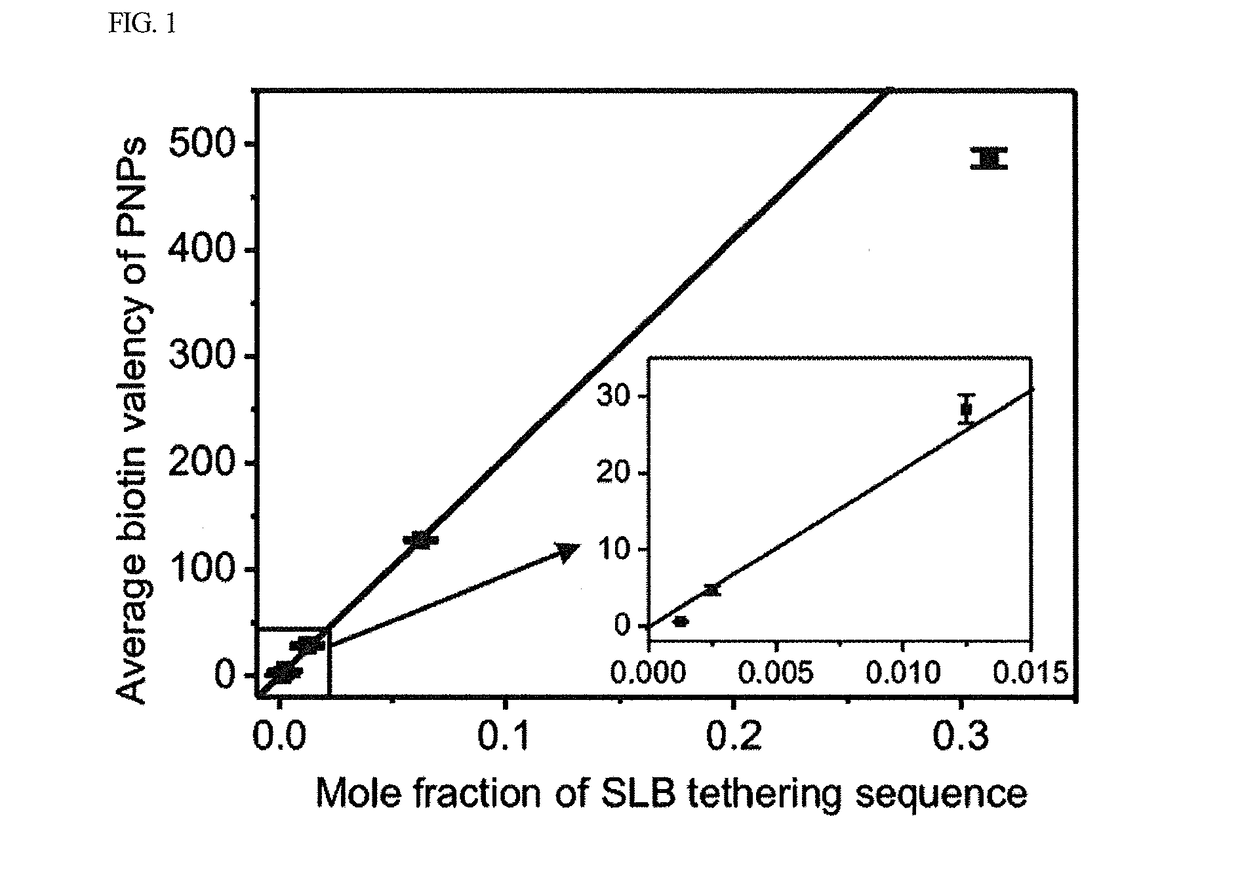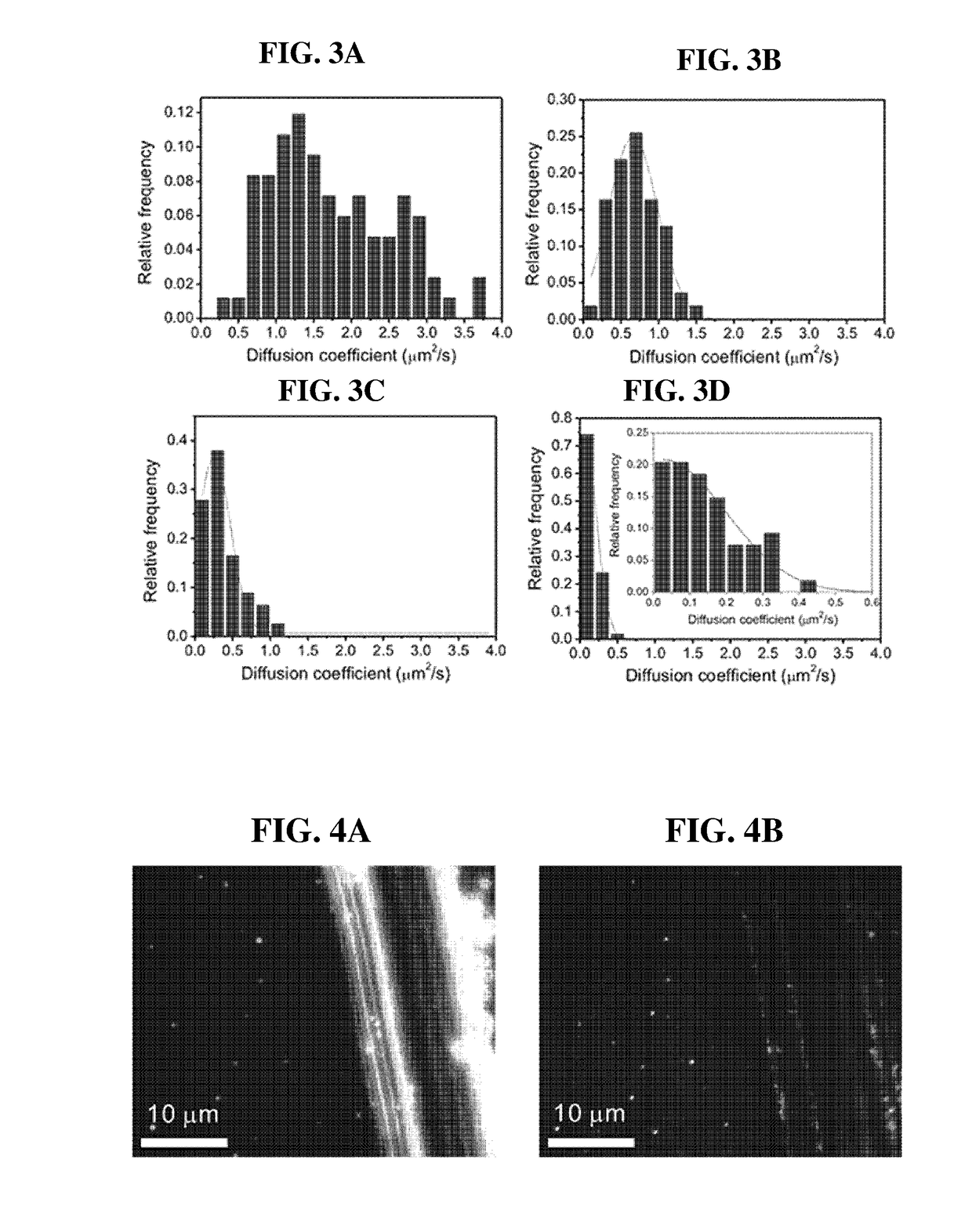Artificial cell membrane comprising supported lipid bilayer connected with probes having controllable mobility and method for analyzing interaction between molecules using the same
a technology of artificial cells and membranes, applied in artificial cell constructs, instruments, measurement devices, etc., can solve the problems of fluorophores blinking and bleaching, complicated setup and procedures, and inability to provide static information of structures in high-resolution imaging methods including electron microscopy
- Summary
- Abstract
- Description
- Claims
- Application Information
AI Technical Summary
Benefits of technology
Problems solved by technology
Method used
Image
Examples
example 1
[0094]1,2-Dioleoyl-sn-glycero-3-phosphocholine (DOPC), 1,2-dioleoyl-sn-glycero-3-phosphoethanolamine-N-(cap biotinyl) sodium salt (biotinylated DOPE), and 1,2-dioleoyl-sn-glycero-3-phosphoethanolamine-N-[methoxy(polyethylene glycol)-1000] ammonium salt (PEG-DOPE) were purchased from Avanti Polar Lipids (Alabaster, Ala., USA). Cy3-modified streptavidin (STV) was purchased from Molecular Probes (Eugene, Oreg., USA). Carboxymethyl polyethylene glycol (M.W. 5000) was purchased from Laysan Bio Inc. (Arab, AL, USA). Bovine serum albumin (BSA), sodium dodecyl sulfate (SDS), and dithiothreitol (DTT) were purchased from Sigma-Aldrich (St. Louis, Mo., USA). A 0.15 M phosphate-buffered saline (PBS) solution was prepared by dissolving NaH2PO4, Na2HPO4, and NaCl (Sigma-Aldrich, St. Louis, Mo., USA) in deionized water (DI water), yielding a 10 mM phosphate buffer solution with 150 mM NaCl (pH 7.4). Further, 0.025 M PBS was prepared to contain 25 mM NaCl with the same reagents. Nanopure water with...
example 2
on of Small Unilamellar Vesicle (SUV
[0095]A supported lipid bilayer (SLB) was formed on a cover glass by the diffusion of SIV containing 97.4 mol % of DOPC, 0.1 mol % of biotinylated DOPE, and 2.5 mol % of PEG-DOPE. A SUV solution was prepared by dissolving an appropriate amount of a lipid in chloroform. A lipid solution was evaporated in a 50 ml round-bottom flask using a rotary evaporator. A lipid film was completely dried under a stream of N2. The dried mixture was resuspended in DI water and subjected to three repetitive freeze-thaw cycles. The total lipid concentration was 2 mg / ml. The solution was extruded more than 21 times through a PC membrane with a pore diameter of 100 nm at 25° C. The resulting SUV solution was kept at 4° C. until use.
example 3
lization of Gold Plasmonic Nanoprobes Using DNA and Quantification of Biotin Valency
[0096]Thiolated oligonucleotides were reduced by incubation with 100 mM PB (pH 8.0) for 2 h and separated by NAP-5 columns (GE Healthcare, Buckinghamshire, UK). For DNA functionalization, freshly reduced 4 M oligonucleotides were mixed with 50 pM AuNPs of 50 nm and incubated at room temperature overnight. For I-PNP, the molar ratio of the SLB tethering sequence to the target capture sequence was 200:600 (mole fraction of SLB tethering sequence: 0.25). For M-PNP the molar ratio was 1:799 (mole fraction of SLB tethering sequence: 0.00125). The solution was then adjusted to yield 10 mM of phosphate buffer and 0.1% (wt / vol) SDS. The adjusted solution was further incubated in an orbital shaker for 30 min and six aliquots of 2 M NaCl were added by 0.05 M increments to obtain a final NaCl concentration of 0.3 M. After each addition of 2 M NaCl, the solution was heated at 55° C. for 10 min and incubated for ...
PUM
 Login to View More
Login to View More Abstract
Description
Claims
Application Information
 Login to View More
Login to View More - R&D
- Intellectual Property
- Life Sciences
- Materials
- Tech Scout
- Unparalleled Data Quality
- Higher Quality Content
- 60% Fewer Hallucinations
Browse by: Latest US Patents, China's latest patents, Technical Efficacy Thesaurus, Application Domain, Technology Topic, Popular Technical Reports.
© 2025 PatSnap. All rights reserved.Legal|Privacy policy|Modern Slavery Act Transparency Statement|Sitemap|About US| Contact US: help@patsnap.com



